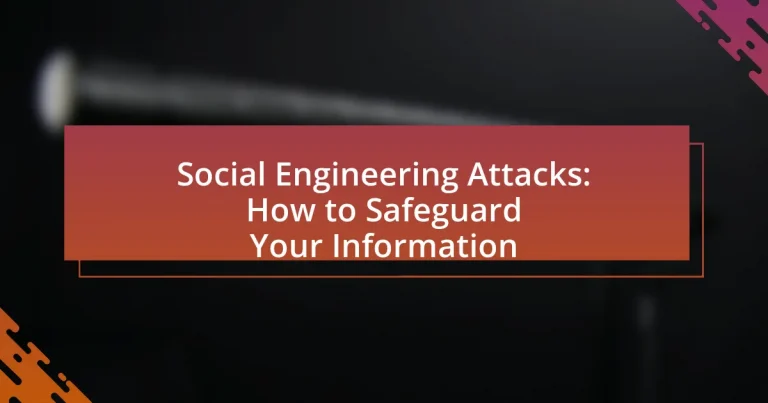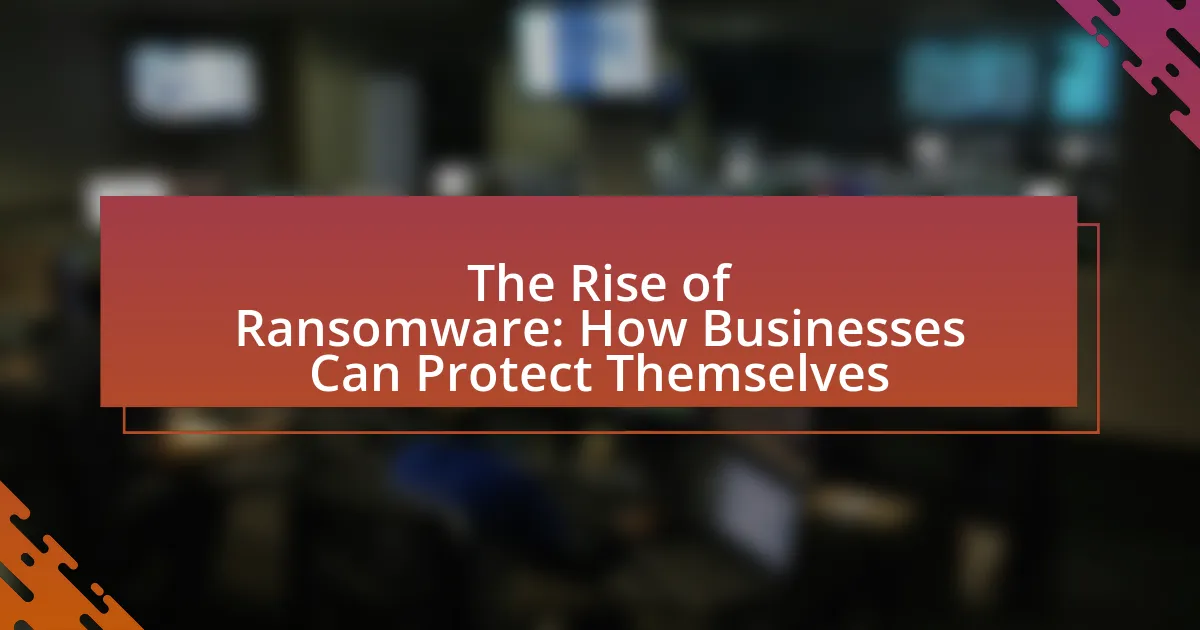Social engineering attacks are manipulative tactics employed by cybercriminals to deceive individuals into revealing confidential information or taking actions that compromise security. This article provides an overview of various social engineering techniques, including phishing, pretexting, baiting, and tailgating, and highlights their psychological underpinnings. It discusses the significant threat these attacks pose to individuals and organizations, emphasizing the importance of awareness and training in identifying and mitigating risks. Additionally, the article outlines best practices for safeguarding information, such as implementing strong passwords, two-factor authentication, and regular software updates, alongside organizational measures to foster a culture of security awareness.

What are Social Engineering Attacks?
Social engineering attacks are manipulative tactics used by cybercriminals to deceive individuals into divulging confidential information or performing actions that compromise security. These attacks exploit human psychology rather than technical vulnerabilities, often involving phishing emails, pretexting, or baiting to gain unauthorized access to sensitive data. According to the 2021 Verizon Data Breach Investigations Report, 36% of data breaches involved social engineering, highlighting the prevalence and effectiveness of these tactics in compromising information security.
How do Social Engineering Attacks work?
Social engineering attacks manipulate individuals into divulging confidential information or performing actions that compromise security. These attacks exploit psychological principles, such as trust and fear, to deceive victims. For example, attackers may impersonate a trusted entity, like a bank or IT support, to gain sensitive data. According to the 2021 Verizon Data Breach Investigations Report, 36% of data breaches involved social engineering tactics, highlighting their prevalence and effectiveness in compromising security.
What techniques are commonly used in Social Engineering Attacks?
Common techniques used in social engineering attacks include phishing, pretexting, baiting, and tailgating. Phishing involves sending fraudulent emails to trick individuals into revealing sensitive information, with a 2021 report indicating that 83% of organizations experienced phishing attacks. Pretexting relies on creating a fabricated scenario to obtain personal data, while baiting offers a false promise to lure victims, such as free downloads. Tailgating involves an unauthorized person gaining physical access to a restricted area by following an authorized individual. These techniques exploit human psychology and trust, making them effective in compromising security.
How do attackers manipulate human psychology in these attacks?
Attackers manipulate human psychology in social engineering attacks by exploiting cognitive biases and emotional triggers. They often create a sense of urgency or fear, prompting individuals to act quickly without critical thinking. For instance, phishing emails frequently use alarming subject lines to provoke immediate responses, leveraging the psychological principle of scarcity to make the recipient feel they might miss out on an opportunity. Research shows that 70% of individuals are likely to click on a link in an email that creates a sense of urgency, demonstrating the effectiveness of this tactic. Additionally, attackers may impersonate authority figures to exploit the tendency to comply with perceived authority, further increasing the likelihood of successful manipulation.
What are the different types of Social Engineering Attacks?
The different types of social engineering attacks include phishing, pretexting, baiting, tailgating, and quid pro quo. Phishing involves tricking individuals into providing sensitive information through deceptive emails or websites. Pretexting occurs when an attacker creates a fabricated scenario to obtain personal information. Baiting entices victims with the promise of a reward, often through malicious downloads. Tailgating involves an unauthorized person gaining physical access to a restricted area by following an authorized individual. Quid pro quo entails offering a service or benefit in exchange for information. These attack types are prevalent, with phishing being the most common, accounting for over 80% of reported security incidents according to the 2021 Verizon Data Breach Investigations Report.
What is Phishing and how does it operate?
Phishing is a cyber attack that involves tricking individuals into providing sensitive information, such as usernames, passwords, or credit card details, by masquerading as a trustworthy entity. It operates primarily through deceptive emails, messages, or websites that appear legitimate, prompting users to click on malicious links or download harmful attachments. According to the Anti-Phishing Working Group, there were over 1.2 million phishing attacks reported in 2020, highlighting the prevalence and effectiveness of this tactic.
What is Pretexting and what are its implications?
Pretexting is a form of social engineering where an attacker creates a fabricated scenario to obtain sensitive information from a target. This technique often involves impersonating a trusted entity, such as a bank or a colleague, to manipulate the victim into divulging personal data. The implications of pretexting are significant; it can lead to identity theft, financial loss, and unauthorized access to confidential information. According to the Federal Trade Commission, identity theft affected over 1.4 million consumers in 2020, highlighting the real-world consequences of such deceptive practices.
How does Baiting differ from other types of attacks?
Baiting differs from other types of attacks primarily in its reliance on the promise of a reward to lure victims into compromising their security. Unlike phishing, which typically involves deception through emails or messages that impersonate legitimate entities, baiting specifically offers something enticing, such as free software or a prize, to entice individuals into downloading malicious content or providing sensitive information. This method exploits human curiosity and greed, making it distinct from other social engineering tactics that may focus more on fear or urgency. For example, a study by the Cybersecurity & Infrastructure Security Agency (CISA) highlights that baiting often involves physical media, like USB drives left in public places, which is a unique characteristic not commonly found in other attack vectors.
Why are Social Engineering Attacks a significant threat?
Social engineering attacks are a significant threat because they exploit human psychology to manipulate individuals into divulging confidential information. These attacks often bypass technical security measures by targeting the weakest link in security—people. For instance, according to the 2021 Verizon Data Breach Investigations Report, 85% of data breaches involved a human element, highlighting the effectiveness of social engineering tactics. This manipulation can lead to unauthorized access to sensitive data, financial loss, and reputational damage for organizations.
What impact do these attacks have on individuals and organizations?
Social engineering attacks significantly impact individuals and organizations by compromising sensitive information and leading to financial losses. Individuals may experience identity theft, emotional distress, and loss of personal assets, while organizations face data breaches, reputational damage, and operational disruptions. For instance, a 2021 report by the Cybersecurity and Infrastructure Security Agency indicated that social engineering attacks accounted for 90% of data breaches, highlighting the pervasive threat these attacks pose. Additionally, the average cost of a data breach for organizations reached $4.24 million in 2021, according to IBM’s Cost of a Data Breach Report, underscoring the financial ramifications of such attacks.
How do Social Engineering Attacks evolve over time?
Social engineering attacks evolve over time by adapting to technological advancements and changing social behaviors. As new communication platforms emerge, attackers exploit these channels to reach victims more effectively; for instance, the rise of social media has led to an increase in phishing attacks that utilize fake profiles to gain trust. Additionally, attackers continuously refine their tactics based on the effectiveness of previous methods, such as transitioning from generic phishing emails to highly personalized spear-phishing campaigns that leverage personal data. Research indicates that 97% of people cannot identify a phishing email, highlighting the ongoing challenge and evolution of these attacks as they become more sophisticated and targeted.

How can you identify Social Engineering Attacks?
You can identify social engineering attacks by recognizing common tactics such as impersonation, urgency, and manipulation of emotions. Attackers often pose as trusted figures, like IT personnel or bank representatives, to extract sensitive information. For instance, a study by the Ponemon Institute found that 55% of organizations experienced social engineering attacks in 2020, highlighting the prevalence of these tactics. Additionally, signs of social engineering include unsolicited requests for personal information, unusual communication methods, and inconsistencies in the information provided. Recognizing these patterns can help individuals and organizations safeguard their information effectively.
What signs indicate a potential Social Engineering Attack?
Signs that indicate a potential Social Engineering Attack include unsolicited communication requesting sensitive information, urgency in the request, and inconsistencies in the sender’s identity or message. These signs are critical as attackers often impersonate trusted entities to manipulate individuals into divulging confidential data. For instance, a study by the Cybersecurity & Infrastructure Security Agency (CISA) highlights that 97% of people cannot identify a phishing email, which is a common method used in social engineering attacks. Additionally, unusual behavior, such as a sudden change in communication style or unexpected requests for personal information, can further signal an attack.
How can you recognize suspicious communication?
You can recognize suspicious communication by identifying inconsistencies, unusual requests, or unverified sources. Suspicious communication often contains poor grammar, urgent language, or requests for personal information that seem out of context. For example, phishing emails frequently use generic greetings instead of personal names and may contain links to unfamiliar websites. According to the Anti-Phishing Working Group, in 2021, over 83% of phishing attacks involved emails that appeared legitimate but contained deceptive elements. Recognizing these signs can help individuals safeguard their information against social engineering attacks.
What role does awareness play in identifying these attacks?
Awareness plays a critical role in identifying social engineering attacks by enabling individuals to recognize suspicious behaviors and tactics used by attackers. When individuals are educated about common social engineering techniques, such as phishing, pretexting, and baiting, they become more vigilant and can detect warning signs that may indicate an ongoing attack. Research indicates that organizations with comprehensive awareness training programs experience a 70% reduction in successful phishing attacks, demonstrating the effectiveness of awareness in enhancing security.
What tools and resources can help in identifying these attacks?
Tools and resources that can help in identifying social engineering attacks include security awareness training programs, phishing simulation tools, and threat intelligence platforms. Security awareness training programs educate employees about the tactics used in social engineering, enhancing their ability to recognize suspicious activities. Phishing simulation tools, such as KnowBe4 or PhishMe, allow organizations to test their employees’ responses to simulated phishing attacks, providing insights into vulnerabilities. Threat intelligence platforms, like Recorded Future or ThreatConnect, aggregate data on emerging threats, enabling organizations to stay informed about the latest social engineering tactics and trends. These resources collectively improve an organization’s defenses against social engineering attacks by fostering awareness and providing actionable intelligence.
What software can assist in detecting phishing attempts?
Software that can assist in detecting phishing attempts includes antivirus programs, email filtering solutions, and dedicated anti-phishing tools. Antivirus programs like Norton and McAfee often include features that identify and block phishing websites. Email filtering solutions such as Proofpoint and Mimecast analyze incoming emails for suspicious links and attachments, reducing the risk of phishing attacks. Additionally, dedicated anti-phishing tools like PhishMe and KnowBe4 provide training and simulations to help users recognize phishing attempts. These tools collectively enhance security by identifying and mitigating potential threats effectively.
How can training programs enhance awareness of Social Engineering?
Training programs can enhance awareness of Social Engineering by educating individuals about the tactics used by attackers and the signs of potential threats. These programs typically include real-world examples and simulations that illustrate how social engineering attacks occur, thereby increasing participants’ ability to recognize and respond to such threats. Research indicates that organizations implementing regular training sessions see a significant reduction in successful phishing attacks, with a study by the Ponemon Institute showing that companies with ongoing security awareness training experience 70% fewer successful breaches. This evidence underscores the effectiveness of training programs in fostering a culture of vigilance and proactive defense against social engineering.

How can you safeguard your information from Social Engineering Attacks?
To safeguard your information from social engineering attacks, implement strong security awareness training for all employees. This training should educate individuals on recognizing phishing attempts, pretexting, and other manipulation tactics used by attackers. According to a study by the Ponemon Institute, organizations that conduct regular security awareness training can reduce the risk of successful social engineering attacks by up to 70%. Additionally, enforce strict verification processes for sensitive information requests, ensuring that employees confirm the identity of the requester through independent channels. Regularly updating security protocols and employing multi-factor authentication can further enhance protection against unauthorized access.
What best practices should you follow to protect yourself?
To protect yourself from social engineering attacks, implement strong password management practices. Use unique, complex passwords for each account, and consider utilizing a password manager to securely store and generate passwords. According to a study by the National Cyber Security Centre, 81% of data breaches are linked to weak or stolen passwords, highlighting the importance of robust password practices. Additionally, enable two-factor authentication (2FA) wherever possible, as it adds an extra layer of security by requiring a second form of verification. Regularly update your software and be cautious of unsolicited communications, verifying the identity of the sender before sharing any personal information.
How can strong passwords and two-factor authentication help?
Strong passwords and two-factor authentication significantly enhance security by making unauthorized access to accounts much more difficult. Strong passwords, which typically include a mix of letters, numbers, and special characters, reduce the likelihood of being easily guessed or cracked through brute force attacks. According to a study by the National Institute of Standards and Technology (NIST), weak passwords are responsible for 81% of data breaches, highlighting the importance of using complex passwords.
Two-factor authentication (2FA) adds an additional layer of security by requiring not only a password but also a second form of verification, such as a text message code or authentication app. This means that even if a password is compromised, an attacker would still need the second factor to gain access. Research from Google indicates that 2FA can block 100% of automated bots and 96% of phishing attacks, demonstrating its effectiveness in safeguarding accounts against social engineering attacks.
What role does regular software updates play in security?
Regular software updates play a critical role in security by patching vulnerabilities that could be exploited by attackers. These updates often include fixes for security flaws identified in the software, which, if left unaddressed, can lead to unauthorized access, data breaches, and other cyber threats. For instance, according to a report by the Cybersecurity and Infrastructure Security Agency (CISA), 85% of successful cyber attacks exploit known vulnerabilities for which patches are available. Therefore, consistently applying software updates significantly reduces the risk of falling victim to social engineering attacks and enhances overall system security.
What organizational measures can be implemented for protection?
Organizational measures that can be implemented for protection against social engineering attacks include employee training, access controls, and incident response plans. Employee training enhances awareness of social engineering tactics, reducing susceptibility to manipulation; studies show that organizations with regular training programs experience a 70% decrease in successful phishing attacks. Access controls limit the information available to employees based on their roles, minimizing the risk of unauthorized access; implementing the principle of least privilege is a widely recognized best practice. Incident response plans ensure that organizations can quickly address and mitigate the effects of social engineering attacks, with research indicating that companies with established response protocols recover 50% faster from security incidents.
How can companies create a culture of security awareness?
Companies can create a culture of security awareness by implementing comprehensive training programs that educate employees about security risks and best practices. Regular training sessions, workshops, and simulations can enhance understanding of social engineering tactics, such as phishing and pretexting, which are prevalent in today’s cyber threats. According to a study by the Ponemon Institute, organizations that conduct regular security awareness training can reduce the likelihood of successful phishing attacks by up to 70%. Additionally, fostering an open environment where employees feel comfortable reporting suspicious activities can further strengthen security culture. By integrating security awareness into the company’s core values and daily operations, organizations can effectively mitigate risks associated with social engineering attacks.
What policies should organizations enforce to mitigate risks?
Organizations should enforce comprehensive security awareness training policies to mitigate risks associated with social engineering attacks. These policies should include regular training sessions that educate employees about recognizing phishing attempts, pretexting, baiting, and other manipulation tactics used by attackers. Research indicates that organizations with ongoing security training programs can reduce the likelihood of successful social engineering attacks by up to 70%. Additionally, implementing strict access control policies, incident response protocols, and regular security audits further strengthens an organization’s defense against potential threats.
What practical steps can you take today to enhance your security?
To enhance your security today, implement strong, unique passwords for all accounts and enable two-factor authentication (2FA) wherever possible. Strong passwords should be at least 12 characters long, combining letters, numbers, and symbols, which significantly reduces the risk of unauthorized access. According to a study by the National Institute of Standards and Technology (NIST), using 2FA can prevent 99.9% of automated attacks, making it a critical step in safeguarding your information against social engineering attacks. Additionally, regularly updating software and being cautious of unsolicited communications can further protect your sensitive data.




